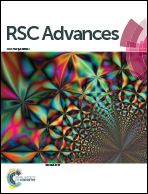3D interconnected networks of a ternary hierarchical carbon nanofiber/MnO2/Ni(OH)2 architecture as integrated electrodes for all-solid-state supercapacitors†
Abstract
We demonstrate the design and fabrication of hierarchical Ni(OH)2 nanosheets vertically grown on a porous carbon nanofiber/MnO2 composite (CF/MnO2) to form three dimensional interconnected networks via a facile hydrothermal process for supercapacitor applications. The obtained CF/MnO2/Ni(OH)2 electrode exhibits high specific capacitance (2079 F g−1 at 0.5 A g−1 in 6 M KOH aqueous solution), rendering its promising application as a potential electrode for supercapacitors. In order to increase the energy density, an asymmetric supercapacitor (ASC) has been successfully fabricated using CF/MnO2/Ni(OH)2 as the positive electrode and CFs as the negative electrode. The as-fabricated all-solid-state ASC device achieves a maximum energy density of 67.6 W h kg−1, highly comparable with the previously reported Ni(OH)2-based ASCs. The present hierarchical CF/MnO2/Ni(OH)2 ternary hybrid brings new opportunities to design and develop high-performance electrode materials for next-generation supercapacitors in flexible electronics.


 Please wait while we load your content...
Please wait while we load your content...